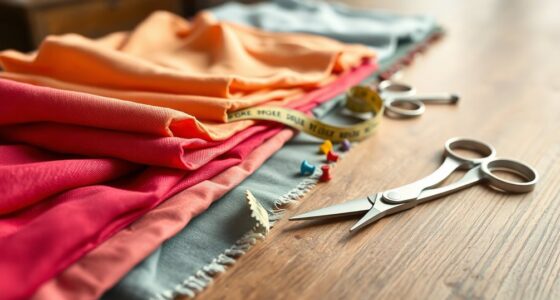Cupro is a luxurious, eco-friendly fabric made from regenerated cellulose, primarily sourced from cotton linter. It feels silky and offers excellent moisture-wicking properties, making it perfect for warm weather. The sustainable manufacturing process minimizes waste and avoids cruelty to silkworms. With vibrant colors and breathability, cupro's gaining popularity in high-end and casual fashion alike. If you want to know what makes cupro a must-try fabric, you'll find more intriguing details ahead!
Key Takeaways
- Cupro is a luxurious, silky fabric made from regenerated cellulose derived from cotton linter, offering a sustainable alternative to silk.
- It features exceptional breathability, moisture-wicking properties, and retains vibrant colors, making it ideal for warm weather and high-end fashion.
- The manufacturing process employs a closed-loop system, recycling chemicals and reducing waste, though it requires careful chemical management to mitigate environmental risks.
- Cupro is increasingly popular in eco-friendly fashion lines, used for garments like evening wear, suits, and casual wear, appealing to sustainable consumers.
- Caring for cupro involves gentle washing, air drying, and low-temperature ironing to maintain its quality and longevity.
What Is Cupro Fabric?

Cupro fabric, often hailed for its luxurious feel, is a unique material made from regenerated cellulose. This semi-synthetic fabric comes from cotton linter, the short fibers discarded during cotton processing.
By dissolving cotton waste in a chemical solution of copper and ammonia, manufacturers create a silky texture that drapes beautifully, much like silk. You'll love how Cupro offers excellent dye retention, making it a favorite in high-end fashion.
Plus, it's biodegradable, which is a significant advantage if you're looking for a sustainable fabric. By utilizing by-products from cotton production, Cupro not only elevates your wardrobe but also supports eco-friendly practices.
If you haven't tried it yet, you're missing out on a luxurious, sustainable option!
The Process of Making Cupro

To understand how cupro is made, you need to look at the chemical treatment process that transforms cotton linter into this luxurious fabric.
It involves a cuprammonium solution that helps dissolve the cellulose, allowing it to be reformed into soft filaments.
Plus, the production employs sustainable techniques by recycling chemicals, although there are environmental concerns to take into account.
Chemical Treatment Process
While many fabrics rely solely on natural fibers, the chemical treatment process for making Cupro transforms cotton linters into a luxurious textile. This innovative method utilizes a cuprammonium solution, breaking down the fibers into a viscous liquid.
Here's how it works:
- Cotton linters are dissolved in a cuprammonium solution, which contains copper oxide and ammonia.
- The cellulose is extruded through spinnerets, forming filaments that are then regenerated in a chemical bath.
- The entire process occurs within a closed-loop system, ensuring chemicals are recovered and reused, despite the initial harsh substances.
Cupro's manufacturing is considered semi-synthetic, combining natural materials with significant chemical transformation to create a stunning fabric alternative to traditional silk.
Sustainable Production Techniques
The process of making Cupro not only showcases innovative techniques but also emphasizes sustainability in textile production. By utilizing cotton waste, specifically cotton linter, Cupro reduces waste in the cotton industry. This closed-loop system recycles chemicals, minimizing environmental impact compared to synthetic fabrics. Recent advancements focus on reducing water consumption and managing pollution risks associated with harsh chemicals like copper and ammonia.
| Aspect | Cupro |
|---|---|
| Sourcing | Cotton linter (by-product) |
| Chemical Management | Closed-loop recycling system |
| Water Consumption | Reduced compared to traditional methods |
| Environmental Impact | Lower than traditional silk |
| Waste Reduction | Significant through cotton waste |
These practices make Cupro a more sustainable choice for eco-conscious consumers.
Characteristics of Cupro: Texture and Feel

When you touch cupro, you'll instantly notice its luxurious silky texture that rivals silk.
This breathable and lightweight fabric not only keeps you comfortable but also retains vibrant colors beautifully.
Whether you're dressing up for an event or enjoying a casual day, cupro elevates your wardrobe with its refined feel.
Luxurious Silky Texture
Cupro fabric offers a luxurious silky texture that elevates any garment it graces. Often compared to silk, this vegan silk alternative feels incredibly soft against your skin, ensuring you enjoy every moment wearing it.
With its elegant drape and flow, cupro enhances your wardrobe in remarkable ways:
- Sustainable Alternative: Made from recycled cotton, it's an eco-friendly choice that doesn't compromise on style.
- Durable: Cupro garments can last 20-30% longer than cotton, providing lasting value.
- Vibrant Colors: Its excellent dyeing capabilities allow for rich, long-lasting hues that won't fade.
When you choose cupro, you're not just opting for luxury; you're making a stylish, sustainable investment.
Breathable and Lightweight
Breathability and lightweight comfort define cupro fabric, making it a perfect choice for warm weather and active lifestyles.
Unlike traditional cotton, cupro fabric excels in moisture absorption, soaking up to 30% more moisture. This breathable quality guarantees you stay dry and comfortable even on the hottest days.
Its lightweight nature allows it to drape effortlessly, enhancing your outfit's style while providing all-day wearability. Plus, cupro's temperature-regulating properties adapt to your body heat, offering consistent comfort across different climates.
As a versatile option in sustainable fashion, cupro not only feels luxurious but also aligns with eco-friendly practices, making it an excellent choice for the conscious consumer.
Embrace the silky-smooth feel of cupro, and enjoy the benefits of breathable, lightweight fabric.
Vibrant Color Retention
Although many fabrics fade over time, cupro stands out for its remarkable ability to maintain vibrant colors.
With its excellent dyeing capabilities, cupro absorbs and holds color more effectively than other materials. This means your garments can keep their bold and flamboyant prints even after multiple washes.
Here are three reasons why cupro excels in color retention:
- Moisture-wicking properties help prevent dye bleeding during washing.
- Silky texture enhances the visual appeal of vibrant hues, giving a luxurious look.
- Fading prevention guarantees that your favorite pieces remain eye-catching for years.
The Sustainability Aspects of Cupro
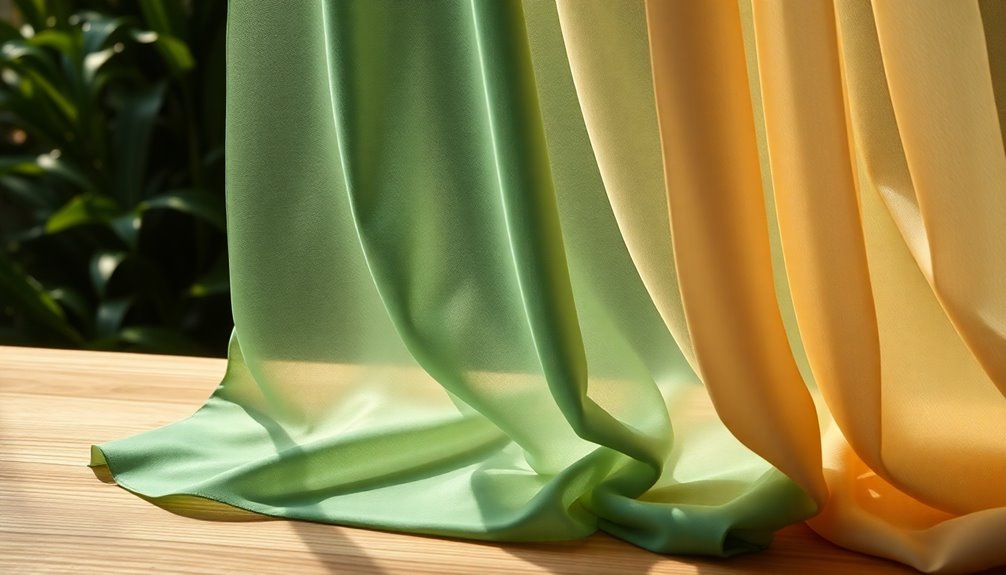
As consumers increasingly seek sustainable alternatives, cupro emerges as a compelling choice due to its eco-friendly properties. Made from cotton linter, a waste product of the cotton industry, cupro considerably reduces waste and promotes sustainability.
Its production process employs a closed-loop system that recycles chemicals, minimizing pollution and environmental impact. Unlike traditional silk, cupro offers a cruelty-free alternative, as it doesn't involve harvesting silkworms.
Additionally, manufacturing cupro requires less water and energy compared to conventional cotton production, enhancing its sustainable and ethical credentials.
However, it's crucial to recognize that if the chemical-heavy production process isn't managed properly, it can pose risks to worker safety and local ecosystems.
Choosing cupro is a step towards more responsible fashion.
Advantages of Choosing Cupro

Choosing cupro offers a multitude of advantages that make it an appealing option for conscious consumers. This fabric isn't only eco-friendly but also provides luxurious benefits.
Here are three key advantages:
- Sustainability: Cupro is made from cotton waste (linters), reducing textile waste and promoting sustainability compared to traditional synthetic fabrics like polyester.
- Vegan alternative: It mimics the silky texture of silk, making cupro a fantastic vegan choice that doesn't harm silkworms.
- Breathability and moisture-wicking: Cupro's breathable properties absorb up to 30% more moisture than cotton, making it perfect for both casual and activewear.
With its vibrant colors and excellent dye retention, cupro stands out as a stylish and sustainable fabric option you'll love. Additionally, the increasing consumer demand for sustainable products is influencing various markets, including textiles.
Disadvantages and Considerations of Cupro
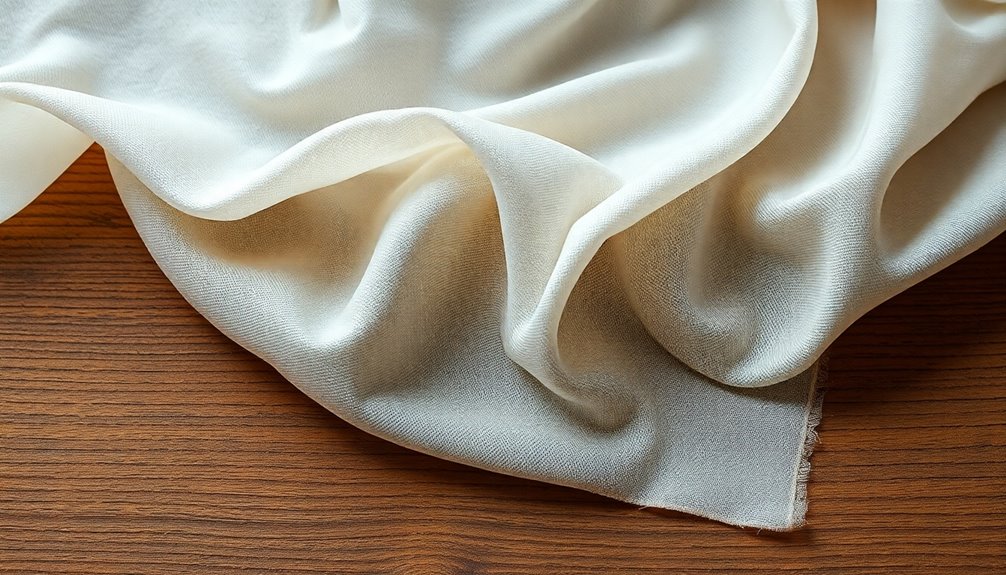
When considering cupro, it's important to weigh its disadvantages alongside its benefits. The production of this fabric involves harsh chemicals like ammonia and caustic soda, which can pose environmental and health risks.
These processes may lead to water pollution if not managed properly, raising concerns about the environmental impact of chemical disposal. Additionally, cupro is highly flammable, posing safety risks at high temperatures.
While it's biodegradable, the chemical-heavy production raises questions about its overall sustainability. You'll also need to care for cupro delicately, as it wrinkles easily and isn't travel-friendly.
These considerations should be kept in mind as you explore the allure of this silky fabric.
Common Uses of Cupro in Fashion

Cupro, often hailed for its luxurious feel and versatility, finds a prominent place in the fashion industry.
This unique cupro fabric is celebrated for its comfort and style, making it an ideal choice for various applications. Here are three common uses:
- High-End Garments: You'll often find cupro as a luxurious lining in suits and outerwear, enhancing both comfort and elegance.
- Evening Wear: As a vegan alternative to silk, cupro offers a similar drape, making it popular for upscale fashion collections.
- Casual and Sustainable Fashion: With its breathability, moisture-wicking properties, and vibrant dyeing capabilities, cupro is increasingly featured in casual wear and eco-friendly lines, reflecting the demand for sustainable fashion and innovative rayon fabrics.
Comparing Cupro to Other Fabrics
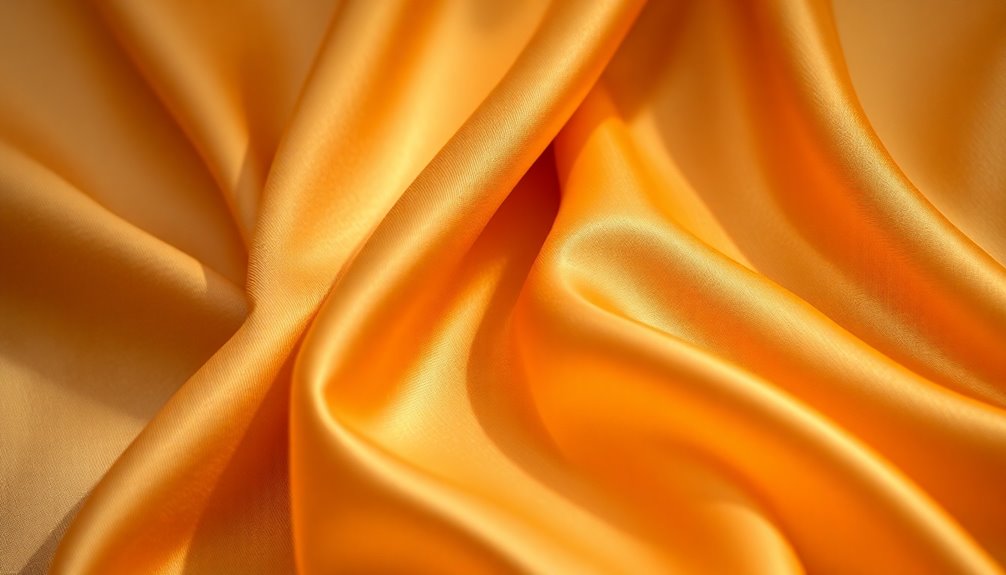
Though many fabrics boast unique qualities, comparing cupro to others reveals its distinct advantages and drawbacks. For instance, while cupro mimics silk's luxurious feel, it stands out for its sustainable production from cotton linter. Unlike traditional rayon, which can come from various cellulose sources, cupro offers a more eco-friendly alternative.
| Fabric | Breathability | Durability |
|---|---|---|
| Cupro | High | 20-30% longer than cotton |
| Rayon | Moderate | Similar to cotton |
| Synthetic | Low | Varies widely |
Fashion brands increasingly favor cupro for its moisture-wicking properties, making it ideal for activewear. However, its production involves harsh chemicals, raising environmental concerns.
Caring for Cupro: Maintenance Tips
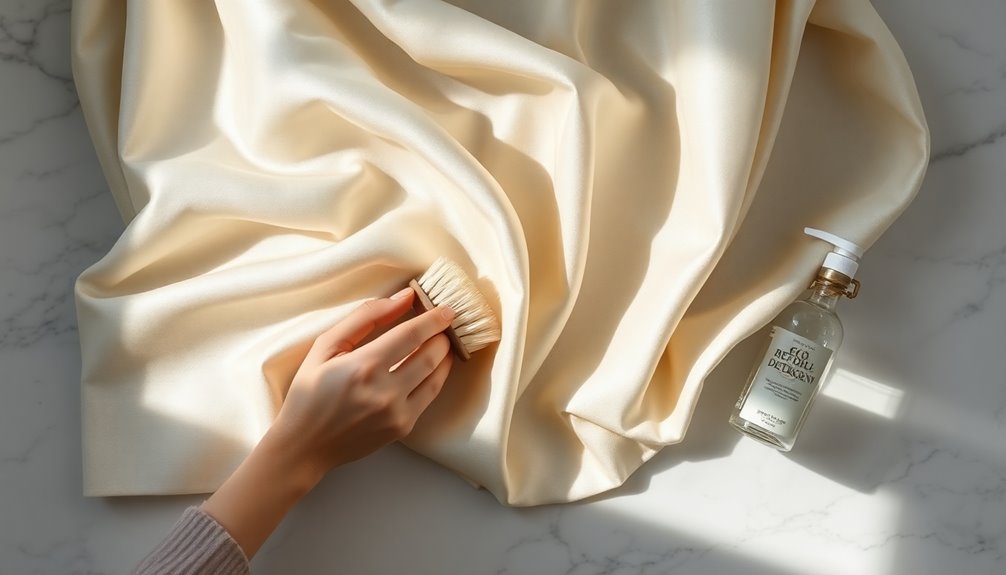
To keep your cupro garments looking their best, it's essential to follow specific care instructions that preserve their softness and longevity. Here are some maintenance tips:
- Washing: Always wash cupro on a gentle cycle in cold water to prevent damage and maintain its soft texture.
- Air Drying: Opt for air drying instead of tumble drying, as the latter can cause shrinkage and fabric deterioration.
- Ironing: When you need to iron, use low temperatures and a pressing cloth to avoid scorching the delicate fibers.
For stain removal, gently blot the area with a mild detergent solution, steering clear of harsh chemicals that could degrade the fabric.
Store your cupro clothing in a cool, dry place away from moisture and direct sunlight.
Ethical Brands Featuring Cupro Products

As consumers increasingly seek sustainable fashion choices, several ethical brands have embraced cupro as a luxurious alternative to traditional silk.
Brands like Komodo and Yahmo prominently feature cupro in their eco-friendly collections, highlighting its sustainability.
Blondegonerogue focuses on local production and uses cupro in modern designs, catering to conscious shoppers.
Project Cece showcases various fairtrade fashion brands offering cupro items, ensuring transparency in sourcing and manufacturing practices.
Additionally, Asahi Kasei is pioneering closed-loop systems in cupro production, recycling chemicals to enhance sustainability.
The growing demand for luxurious, cruelty-free textiles reflects a shift in consumer preferences, with cupro expected to grow at a 6.2% CAGR from 2021 to 2028, making it a smart choice for your wardrobe.
Frequently Asked Questions
What Are the Disadvantages of Cupro Fabric?
When considering cupro fabric, you'll find several disadvantages.
Its production involves harsh chemicals, raising environmental and health concerns. You might notice that cupro is flammable at high temperatures and leaves a residue when burnt.
The fabric wrinkles easily, making it less travel-friendly, and it requires delicate washing—no tumble drying allowed.
While it's biodegradable, the chemical-heavy manufacturing process can be alarming for those concerned about pollution and worker safety.
Is Cupro a Good Fabric?
You'll find that cupro is a good fabric if you appreciate luxury and comfort. Its silky texture feels great against your skin, and it's breathable and moisture-wicking, making it perfect for various climates.
However, keep in mind that it can wrinkle easily and requires careful washing. While it offers durability, the environmental concerns related to its production might give you pause.
What Is Another Name for Cupro?
Another name for cupro is ammonia silk, which highlights its luxurious, silky texture.
You might also come across the term cuprammonium rayon, referring to the specific chemical process used in its production.
When shopping, keep an eye out for Bemberg, a high-quality brand of cupro.
This fabric is often labeled as vegan silk due to its production from cotton waste, making it a cruelty-free alternative to traditional silk.
Can Cupro Go in a Washing Machine?
Imagine your favorite silk scarf dancing in the breeze—that's how cupro feels.
Yes, you can toss cupro in the washing machine, but it's best to treat it gently. Use a cold, delicate cycle to keep its luxurious touch intact.
Avoid bleach and harsh detergents, as they're like storm clouds over your fabric's sunny disposition.
Air drying is key; high heat can shrink it faster than you can say "fashion faux pas."
Conclusion
In choosing cupro, you're embracing luxury, sustainability, and comfort. You'll feel the silky softness against your skin, enjoy the breathability, and appreciate the eco-friendly production. By opting for this unique fabric, you support innovative fashion and ethical practices. So, whether you're dressing up for a special occasion or seeking everyday elegance, cupro offers you a revitalizing alternative. Step into a world where style meets conscience, and let cupro transform your wardrobe today!


